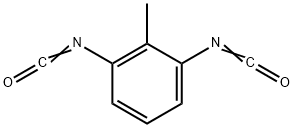91-08-7

Product Name:
2-METHYL-M-PHENYLENE DIISOCYANATE
Formula:
C9H6N2O2
Synonyms:
2-Methyl-m-phenylene diisocyanate;Tolylene-2,6-diisocyanate
Inquiry
CHEMICAL AND PHYSICAL PROPERTIES
| Physical Description | Toluene-2,6-diisocyanate is a liquid. Used in the manufacture of polyurethane foams, elastomers, and coatings; crosslinking agent for nylon 6. (EPA, 1998) |
|---|---|
| Color/Form | Colorless to yellow liquid ... turns pale yellow on exposure to air |
| Odor | Pungent |
| Boiling Point | 264 to 271 °F at 18 mmHg (EPA, 1998) |
| Melting Point | 68 to 72 °F for a 80% 2,4:20% 2,6 TDI mixture (EPA, 1998) |
| Flash Point | 270 °F for a 80% 2,4:20% 2,6 TDI mixture (EPA, 1998) |
| Solubility | Reaction (NTP, 1992) |
| Density | 1.22 at 77 °F for a 80% 2,4:20% 2,6 TDI mixture (EPA, 1998) - Denser than water; will sink |
| Vapor Density | 6 |
| Vapor Pressure | 0.5 mmHg at 77 °F for a 80% 2,4:20% 2,6 TDI mixture (EPA, 1998) |
| Decomposition | When heated to decomposition, it emits highly toxic fumes of ... /nitrogen oxides/. |
| Polymerization | The diisocyanate may undergo exothermic polymerization in contact with bases or more than traces of acyl chlorides, sometimes used as stabilizers. /2,4-Toluene diisocyanate/ |
| Odor Threshold | Odor Threshold Low: 0.05 [mmHg] Odor threshold = 50 ppb with about 1/2 of volunteers detecting and identifying the material at 400 ppb |
| Refractive Index | Index of refraction: 1.5708 at 20 °C/D |
| Other Experimental Properties | Conversion factor: mg/cu m = 7.12 X ppm |
| Chemical Classes | Plastics & Rubber -> Diisocyanates |
SAFETY INFORMATION
| Signal word | Danger |
|---|---|
| Pictogram(s) |
 Skull and Crossbones Acute Toxicity GHS06  Health Hazard GHS08 |
| GHS Hazard Statements |
H315:Skin corrosion/irritation H317:Sensitisation, Skin H319:Serious eye damage/eye irritation H330:Acute toxicity,inhalation H334:Sensitisation, respiratory H335:Specific target organ toxicity, single exposure;Respiratory tract irritation H351:Carcinogenicity H412:Hazardous to the aquatic environment, long-term hazard |
| Precautionary Statement Codes |
P202:Do not handle until all safety precautions have been read and understood. P273:Avoid release to the environment. P280:Wear protective gloves/protective clothing/eye protection/face protection. P302+P352:IF ON SKIN: wash with plenty of soap and water. P305+P351+P338:IF IN EYES: Rinse cautiously with water for several minutes. Remove contact lenses, if present and easy to do. Continuerinsing. |
COMPUTED DESCRIPTORS
| Molecular Weight | 174.16 g/mol |
|---|---|
| XLogP3 | 3.9 |
| Hydrogen Bond Donor Count | 0 |
| Hydrogen Bond Acceptor Count | 4 |
| Rotatable Bond Count | 2 |
| Exact Mass | 174.042927438 g/mol |
| Monoisotopic Mass | 174.042927438 g/mol |
| Topological Polar Surface Area | 58.9 Ų |
| Heavy Atom Count | 13 |
| Formal Charge | 0 |
| Complexity | 239 |
| Isotope Atom Count | 0 |
| Defined Atom Stereocenter Count | 0 |
| Undefined Atom Stereocenter Count | 0 |
| Defined Bond Stereocenter Count | 0 |
| Undefined Bond Stereocenter Count | 0 |
| Covalently-Bonded Unit Count | 1 |
| Compound Is Canonicalized | Yes |
PRODUCT INTRODUCTION
description
Toluene-2,6-diisocyanate is a liquid. Used in the manufacture of polyurethane foams, elastomers, and coatings; crosslinking agent for nylon 6. (EPA, 1998)